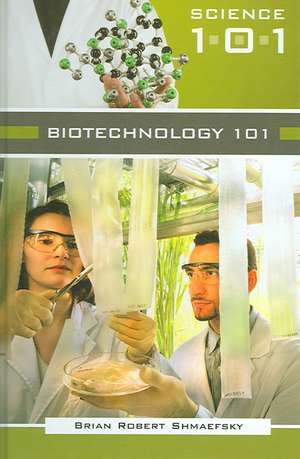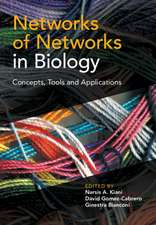Biotechnology 101: Science 101
Autor Brian R. Shmaefskyen Limba Engleză Hardback – 29 oct 2006 – vârsta până la 17 ani
Preț: 228.47 lei
Preț vechi: 392.56 lei
-42% Nou
Puncte Express: 343
Preț estimativ în valută:
43.72€ • 46.75$ • 36.45£
43.72€ • 46.75$ • 36.45£
Carte tipărită la comandă
Livrare economică 18 aprilie-02 mai
Preluare comenzi: 021 569.72.76
Specificații
ISBN-13: 9780313335280
ISBN-10: 0313335281
Pagini: 272
Dimensiuni: 156 x 235 x 25 mm
Greutate: 0.55 kg
Ediția:Parental Adviso.
Editura: Bloomsbury Publishing
Colecția Greenwood
Seria Science 101
Locul publicării:New York, United States
ISBN-10: 0313335281
Pagini: 272
Dimensiuni: 156 x 235 x 25 mm
Greutate: 0.55 kg
Ediția:Parental Adviso.
Editura: Bloomsbury Publishing
Colecția Greenwood
Seria Science 101
Locul publicării:New York, United States
Notă biografică
Brian Robert Shmaefsky is a professor of biology at Kingwood College in Texas. He was an industrial chemist in the biotechnology industry before becoming a college professor who teaches biology and biotechnology. Dr. Shmaefsky studied at Brooklyn College in New York and did his graduate work at Southern Illinois University and the University of Illinois. He continues to consult in the biotechnology industry and trains teachers to perform biotechnology in their classrooms.
Cuprins
Series ForewordPreface1. The Definition of BiotechnologyIntroductionContemporary Definitions of BiotechnologyCategories of Biotechnology2. Basic Science of BiotechnologyChemistry and Physics of BiotechnologyBasic Biology of Biotechnology3. The Tools of BiotechnologyIntroductionThe ToolsAmino Acid AnalyzersAmino Acid SequencersBalanceBioreactorBlotting ApparatusCentrifugeChromatographyChromatogram Scanner/DensitometerCryopreservation EquipmentCytometerDNA SequencerElectrophoresisElectroporation InstrumentFiltration ApparatusGel ReaderGene GunIncubatorIsoelectric Focusing ApparatusLIMSLyophilizerMicroarray TechnologyMicroplate ReaderMicroscopeMicrotomeMixerNanotechnologyNuclear Magnetic Resonance Imaging InstrumentParticle SizerpH MeterPipettePolarimeterRheometerSpectrophotometerThermocyclerThermometer ProbesWater BathWater Titrator4. Biotechnology InnovationsThe Creation of InnovationsHistory of Biotechnology InnovationsBiotechnology InnovationsGenomic Analysis TechniquesGenomic Expression TechniquesProteomics TechniquesMetabolomicsProduction of Genetically Modified OrganismsCloning5. Principal People of BiotechnologyIntroductionContributors to BiotechnologyAl-KindiW. French AndersonWerner ArberOswald T. AveryDavid BaltimoreGeorge W. BeadleWilliam James BealPaul BergHerbert BoyerSydney BrennerPat BrownGeorge Washington CarverErwin ChargaffMartha ChaseStanley CohenStanley N. CohenFrancis S. CollinsGerty and Carl CoriFrancis CrickCharles DarwinFélix d'HerelleMax DelbrückHugo de VriesRenato DulbeccoPaul EhrlichAlexander FlemingRosalind FranklinGalenArchibald GarrodWalter GilbertFrederick GriffithHenry HarrisAlfred HersheyDavid HoLeroy HoodRobert HookeJohn HunterFrançois JacobZacharias JanssenAlec JeffreysEdward JennerErnest Everett JustHar Gobind KhoranaShibasaburo KitasatoRobert KochArthur KornbergPhilip LederJoshua LederbergAntony van LeeuwenhoekRita Levi-MontalciniSalvador LuriaAndré LwoffBarbara McClintockIlya MechnikovGregor MendelJohann Friedrich MiescherCésar MilsteinJacques MonodThomas MorganHermann MullerKary MullisDaniel NathansMarshall NirenbergSevero OchoaReiji and Tsuneko OkazakiRichard PalmiterLouis PasteurLinus PaulingMax PerutzStanley PrusinerSteven RosenbergPierre Paul Emile RouxRobert RushmerFrederick SangerMatthias SchleidenTheodor SchwannMaxine SingerLazzaro SpallanzaniHermann StaudingerNettie StevensAlfred Henry SturtevantWalter SuttonWaclaw SzybalskiHoward TeminArne TiseliusAlexander ToddHarold VarmusCraig VenterRudolf VirchowJames WatsonMaurice WilkinsIan WilmutGlossaryReferences and ResourcesPrintWebIndex
Recenzii
Shmaefsky addresses basic principles along with techniques, applications, and tools used in the science of biotechnology. He provides a historical overview of the origins of biotechnology and innovations used relating to agriculture, commercial manufacturing, consumer products, and medicine. Included is a selective but extensive listing of a diverse group of scientists, with each one's brief biography and role in contributing to the principles and development of biotechnology. Also provided is a glossary of terms, an annotated bibliography of print resources for books and references to articles, and Web sites on or relating to biotechnology. This book will interest those in all areas of the sciences, as well as engineering, legal, health, and medical professions. Biotechnology 101 is a volume in the series Science 101, which provides a concise but easy understanding of the concepts of scientific research. Recommended. All levels.
Editor's Choice Biotechnology 101is just what it ought to be: It sounds like a broad introduction to a complex field of study, that that's just what the reader gets. For introductory students and, perhaps even more importantly journalists and policy makers, the book provides a quick, concise introduction to the science, methods, potential, and history of this important field..[t]he explanations are clear, the issues carefully laid out, and the illustrations simple, yet very useful. In a relatively short space of time, the book should allow a person with little background in biology to understand the fundamental concepts that underlie problems in modern biotechnology.
For students and general readers, Shmaefsky, a former industrial chemist in the biotechnology industry, presents an introduction to biotechnology, its definition and basic science, with primary focus on tools, innovations, and key figures. The volume devotes about a quarter of its text to this last section, providing brief biographies of figures such as Charles Darwin, James Watson, Louis Pasteur, Maxine Singer, Gregor Mendel, Alec Jeffreys, and many others. The list of references and other resources is annotated.
Editor's Choice Biotechnology 101is just what it ought to be: It sounds like a broad introduction to a complex field of study, that that's just what the reader gets. For introductory students and, perhaps even more importantly journalists and policy makers, the book provides a quick, concise introduction to the science, methods, potential, and history of this important field..[t]he explanations are clear, the issues carefully laid out, and the illustrations simple, yet very useful. In a relatively short space of time, the book should allow a person with little background in biology to understand the fundamental concepts that underlie problems in modern biotechnology.
For students and general readers, Shmaefsky, a former industrial chemist in the biotechnology industry, presents an introduction to biotechnology, its definition and basic science, with primary focus on tools, innovations, and key figures. The volume devotes about a quarter of its text to this last section, providing brief biographies of figures such as Charles Darwin, James Watson, Louis Pasteur, Maxine Singer, Gregor Mendel, Alec Jeffreys, and many others. The list of references and other resources is annotated.























